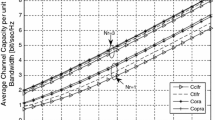Abstract
Alamouti orthogonal space-time block code (Alamouti in IEEE J Sel Areas Commun 16(8):1451–1458, 1998) has been applied widely in wireless communication, e.g., IEEE 802.16e-2005 standard. In this paper, theoretical analysis of symbol error rate performance for Alamouti orthogonal space-time block code (AOSTBC) over time-selective fading channels with a zero-forcing linear receiver is derived. Firstly, a closed-form expression (i.e., not in integral form) is derived for the average symbol pair-wise error probability (SPEP) in time-selective frequency-nonselective independent identically distributed Rayleigh fading channels. Then, the SPEP is used to derive a tight upper bound (UB) for the symbol-error rate (SER) of AOSTBC via establishing algorithmic Bonferroni-type upper bound. Extensive simulation results show that the curves for the UB coincide with the simulated SER curves for various antenna configurations even at very low signal-to-noise ratio regimes. The UB thus can be used to accurately predict the performance of AOSTBC code over time-selective fading channels when a zero-forcing receiver is used.



Similar content being viewed by others
References
Alamouti, S. M. (1998). A simple transmitter diversity scheme for wireless communications. IEEE Journal on Selected Areas in Communication, 16(8), 1451–1458.
Tarokh, V., Seshadri, N., & Calderbank, A. R. (1998). Space-time block coding for wireless communications: Performance results. IEEE Journal on Selected Areas in Communication, 17(3), 451–460.
Naguib, A. F., Seshadri, N., & Calderbank, A. R. (1998). Applications of space-time block codes and interference suppression for high capacity and high data rate wireless systems. In Systems and computers: Conference record of thirty-second asilomar conference on signals, pp. 1803–1810.
Liu, Z., Ma, X., & Giannakis, G. B. (2002). Space-time coding and Kalman filtering for time-selective fading channels. IEEE Transactions on Communications, 50(2), 183–186.
Tran, T. A., & Sesay, A. B. (2004). A generalised simplified ML decoder of orthogonal space-time block code for wireless communications over time-selective fading channels. IEEE Transactions on Wireless Communications, 3(3), 855–964.
Vielmon, A., Li, Y. (G.), & Barry J. R. (2004). Performance of Alamouti transmit diversity over time-varying Rayleigh-fading channels. IEEE Transactions on Wireless Communications, 3(5), 1369–1373.
Wu, J., & Saulnier, G. J. (2007). Orthogonal space-time block code over time-varying flat-fading channels: Channel estimation, detection, and performance analysis. IEEE Transactions on Wireless Communications, 55(5), 1077–1087.
Kuai, H., Alajaji, F., & Takahara, G. (2000). Tight error bounds for non-uniform signaling over AWGN channels. IEEE Transactions on Information Theory, 46(11), 2712–2718.
Jakes, W. C. (1974). Microwave mobile communication. New York: Wiley.
Gradshteyn, I. S., & Ryzhik, I. M. (2007). Table of integrals, series, and products (7th ed.). San Diego, CA: Academic.
Behnamfar, F., Alajaji, F., & Linder, T. (2005). Tight error bounds for space-time orthogonal block codes under slow Rayleigh flat fading. IEEE Transactions on Wireless Communications, 53(6), 952–956.
http://functions.wolfram.com/HypergeometricFunctions/Hypergeometric1F1/03/01/02/0011/. Accessed 28 March 2013.
http://functions.wolfram.com/HypergeometricFunctions/LaguerreL3General/06/01/03/01/02/0001/. Accessed 28 March 2013.
Acknowledgments
This work was partially supported under Project 39/2012/HÐ/NÐT granted by the Ministry of Science and Technology of Vietnam.
Author information
Authors and Affiliations
Corresponding author
Appendix
Appendix
Assume that \(\rho ^{2}<1\), let us introduce the random variables \(\varepsilon _{1k}\) and \(\varepsilon _{2k}\), \(k = 1,\ldots , N\)
By construction, \(\varepsilon _{1k}\) and \(\varepsilon _{2k}\) are independent and identically distributed with the same PDF as \(h_{1k}\)(2) and \(h_{2k}\)(1), and furthermore, \(\varepsilon _{1k}\) is independent of \(h_{1k}\)(2), \(\varepsilon _{2k}\) and is independent of \(h_{2k}\)(1). Plugging (29) into (10) leads to
To simplify this expression further, observe that the fraction in (30) can be expressed as an inner product
where \(z_{1}, z_{2}\) are real variables, \({{\varvec{h}}}=\left[ {h_{11} \left( 2 \right) ,h_{21}^*\left( 1 \right) ,\ldots ,h_{1N} \left( 2 \right) ,h_{2N}^*\left( 1 \right) } \right] ^{\text{ T }}\) and \({{\varvec{e}}}=\left[ {\xi _{11}^*,\xi _{21} ,\ldots ,\xi _{1N}^*,\xi _{2N} } \right] ^{\text{ T }}\). Since \({{\varvec{e}}}\) is symmetric, the distribution of \(z_{1} + \text{ j }z_{2}\) reduces to the distribution of \(h_{1k}\)(1), independent of \({{\varvec{h}}}\) (and, thus, also independent of \(\left\| {{\varvec{h}}} \right\| )\). Thus, (30) simplifies to
where \(A=\sqrt{\alpha _1 \frac{\rho ^{2}SNR}{2}\Delta _s^2 }\) and \(X_i =\sqrt{\left( {1-\rho ^{2}} \right) \frac{SNR}{2}\Delta _s^2 }z_i \). Therefore, given \(A, \omega \) has a noncentral chi-square distribution with two degrees of freedom, and PDF
where \(J_{0}(\cdot )\) is the zeroth-order Bessel function of the first kind, \(c=\frac{SNR}{2}\Delta _s^2 \) and \(\text{ j }=\sqrt{-1}\).
However, \(A=\sqrt{\alpha _1 \frac{\rho ^{2}SNR}{2}\Delta _s^2 }=\sqrt{\alpha _1 \rho ^{2}c}\) is Rayleigh distributed with \(2N\) degrees of freedom, and PDF
Integrating the product of (34) and (35) over the variable from 0 to \(\infty \) leads to the following density probability for \(\omega \) as
From (37), by using [10, Eq. (6.631.1)] we obtain
where \(_1 F_1 \left( {\alpha ,\beta ;z} \right) \) is Kummer confluent hypergeometric function [10]. By applying the transform equations given in [12, 13] we have
Plugging (39) into (38) leads to
It is very interesting that the calculation process from (29) to (40) is performed under assumption \(\rho ^{2}<1\). However, the final result (40) is general and can apply any value of \(\rho \) (which includes \(\rho ^{2} = 1\)). The proof is not difficult, so it is omitted here for brevity.
Rights and permissions
About this article
Cite this article
Pham, VB., Sheng, WX. Performance Analysis of Alamouti Space-Time Block Code Over Time-Selective Fading Channels. Wireless Pers Commun 73, 401–413 (2013). https://doi.org/10.1007/s11277-013-1194-9
Published:
Issue Date:
DOI: https://doi.org/10.1007/s11277-013-1194-9




